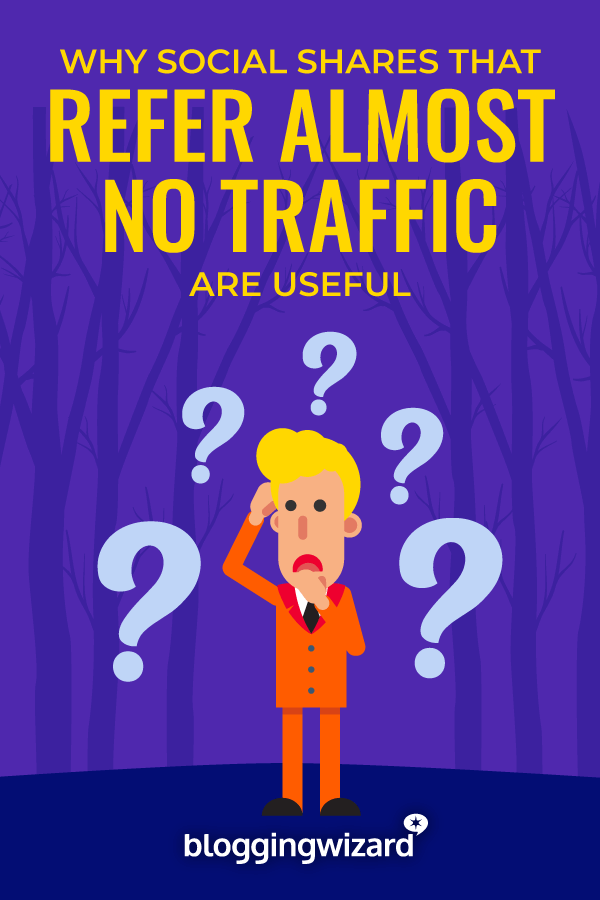Why Social Shares That Refer Almost No Traffic Are Useful

Most social shares refer almost no traffic.
That makes the majority of social shares sound pretty meaningless, right?
Wrong.
Here’s the deal:
Social shares that send almost no traffic to your site can be useful.
In this post, you will learn exactly how these seemingly meaningless social shares can help your business.
Let’s jump in:
Google will index your content faster
After over 10 years of building and marketing websites, I’ve been asked this question countless times…
“How do I get Google to index my content faster?”
And, no, it doesn’t involve buying an “indexing service” from a shonky web host.
The most common method is to submit your sitemap within Google Search Console.
But there’s a faster way:
Tweets using popular hashtags.
One of the great things about Twitter is that Google uses it as a news source.
It’s not like Facebook’s walled garden. Twitter crawls and indexes tweets.
So, if you want your content indexing fast, tweet it out using popular hashtags.
Note: Want our latest content delivered to your inbox? Click here to subscribe to the free Blogging Wizard newsletter.
Social shares can improve your search engine rankings
There’s a lot of confusion surrounding the impact social shares have on search rankings.
That’s partly due to the huge volume of correlation studies. Correlation doesn’t equal causation so I typically take these with a pinch of salt.
However, the benefits of social media shares for SEO are fairly clear.
First off, social shares are a direct ranking factor in Bing. This has been confirmed in Bing’s Webmaster Guidelines.
So, more social shares will directly improve your rankings in Bing.
What about Google?
Social shares will not directly impact your Google rankings. But they can have an indirect impact. More content about your brand can only be a good thing.
Whether that be social media posts or articles on other websites. It’s all helpful.
All of this content can help your rankings indirectly. For example, link earning and increased brand searches are the main ones.
There’s also co-citation and co-occurrence which could be a factor.
Let me explain:
With co-citation, simply having more brand mentions on the web is something Google will take note of. Regardless of whether those mentions actually link to your website.
And, with co-occurrence, Google will look at keywords and brands in close proximity to one another.
Exactly how much co-citation and co-occurrence can help remains to be seen. Only Google really knows.
But making your content more visible on the web opens you up more to earning more links, and other opportunities – its these that will benefit your rankings directly.
The takeaway? Social shares, regardless of how much traffic they refer, are a good thing for your SEO.
Note: There are those in the SEO space that say “social media has no effect on SEO.” That kind of statement is void of context and slightly misleading. And what they really mean is “social media has no direct effect on Google rankings.” – Like I mentioned above, there are indirect benefits worth pursuing. And then there are the social media benefits that will positively impact other areas of your business.
A single click can drive significant revenue
A few clicks couldn’t possibly have a meaningful impact on your revenue, right?
Well, it depends on your business.
If you rely on ads for revenue, or affiliate marketing, chances are that it won’t.
But if you run a service based business? Oh damn. It can!
It doesn’t matter whether we’re talking about social shares, guest posts, or any other tactic. A single click has the potential to drive significant revenue.
I know because I’ve seen a single click turn into a customer that spent over $40,000 over the lifetime of his account.
In fact, I helped build an agency off the back of guest posts and social shares that referred hardly any traffic. A 6 figure business in 3-4 months. Crazy right?
In terms of traffic referred to our site, there are those that would consider our guest posting & social media strategy to be a failure.
But the revenue tells a different story.
And it is a similar case for many freelancers & agencies.
Each click matters.
How to get more social shares
You’ll need to be regularly sharing your own blog posts. Social scheduling tools are a huge time saver here.
But how do you get more social shares from other people?
There are tactics you can use to encourage social sharing on your own blog. Such as using click-to-tweet blocks, social sharing buttons, etc.
The challenge? These tactics rely on you actually having blog traffic in the first place.
And they can be somewhat slow to get the ball rolling.
A quicker approach is to use content promotion platforms.
There are three in particular that work well for getting more shares:
Viral Content Bee has been around for the longest and can be used for free. It is built upon the concept of reciprocal sharing. You share other people’s stuff and they share yours.
Missinglettr (aff), this popular social media tool has launched an add-on called Curate. You can use it to source content to share and get your own content shared.
I’ve had good results from Missinglettr so far but there are some niches that don’t get much traction on that platform. Regardless, it’s well worth trying.
Quuu Promote (aff) is my go-to content promotion platform. It is the most expensive of the three but I’ve had the best results from this platform. They have the strongest user base which generally means more shares across a wider variety of niches.
Now, there are a few caveats with these tools:
First, a quick disclosure: I’m an affiliate for Missinglettr and Quuu Promote so take from that what you will. I’ve had good results from these platforms but your mileage may vary.
Now for the important part… how to get results from these types of platforms.
Note: The thinking behind this will apply to getting results from any tool, tactic, or strategy you implement.
Experimentation is key with these types of tools.
Every so often I come across “case studies” from bloggers who share two articles with extremely niche appeal and decide these platforms don’t work. At all. For anyone. What?!
Any good experiment requires a larger pool of content. Otherwise the results will be meaningless.
If you want to make any tool (or even tactic/strategy) work for you, you need to look at the variables that can impact your results first.
For these tools, these are the variables to consider:
- Your headline
- Your niche (broad vs limited appeal)
- The time/day you submit content
- The volume of content you submit
- The popularity of your niche for that platform
- The time it takes for scheduled posts to be published
Remember: some content will fall flat on its face and that isn’t a bad thing. When it does, it is likely due to one or more of the variables I mentioned above.
Let’s take Missinglettr Curate as an example.

Some of my posts have done extremely well on this platform where others have fallen flat.
I can usually guess which articles aren’t going to perform well. Reviews are always going to struggle because that content type doesn’t align well with social shares.
It is typically the more unique and interesting headlines that will do better. Especially those with broad appeal.
So, working on your headline writing skills is extremely important to ensure you get the most value out of platforms like these.
Wrapping it up
As we’ve seen, social shares that refer very little traffic can still be useful.
They can help your content get indexed by search engines faster. They can help with your SEO from a broader perspective.
They can also help you acquire more customers.
Particularly if you are planning to launch your blog, or your blog is in the early stages of growth, these clicks matter even more.
It is these visitors that can become regular readers. And if things go well, some of those readers will turn into friends.
So, take every opportunity you can to make your content more visible. Even if the metrics don’t sound too impressive, they can still help you and open up exciting new opportunities.
What’s the next step? Give your readers a better reason to return to your blog by building your email list. Check out my definitive list building guide to learn how.
Disclosure: Our content is reader-supported. If you click on certain links we may make a commission.

